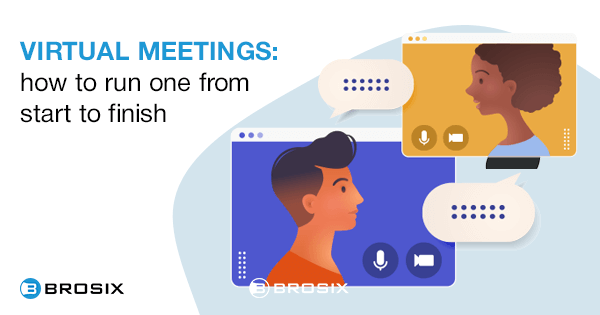Remote work and virtual meetings have become increasingly important aspects of our lives. Many businesses had already adopted more remotely-friendly ways of working as the COVID-19 pandemic significantly accelerated.
What is a virtual meeting?
A virtual meeting is a digital meeting where team members meet online to address and discuss professional issues.
This online meeting usually takes place through video conferences or video calls, via Skype, Zoom, and even WhatsApp and Telegram.
A virtual meeting focuses on:
- Addressing day-to-day problems
- Organizing tasks and projects
- Defining business strategies
- Making decisions
- Exchanging information and knowledge
- Coordinating various issues that influence the growth of organizational development
Benefits of virtual meetings
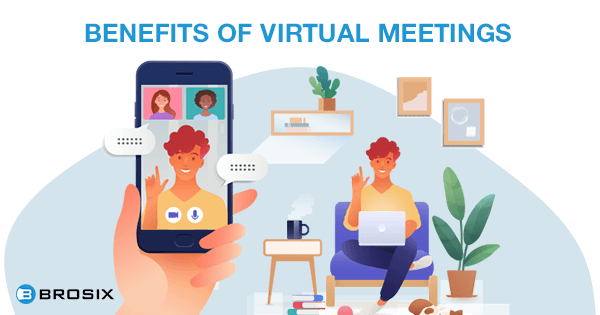
Reduction of travel time and costs
Since it’s unnecessary to travel to the workplace, you can use video conferences and virtual meetings to cut the costs on travel time, transfers and similar services.
This positively influences productivity and contributes to caring for the environment by requiring less public transport or personal vehicles.
Facilitates and enhances teamwork
By relying on video calls and virtual meetings, it’s much easier to integrate various team members that work remotely and enhance communication.
Thanks to the possibilities that virtual meetings provide, different departments of the organization can feel like a part of a whole, even though they are not physically close.
Increase in productivity and effectiveness
Without being tied to a specific space or circumstances, virtual meetings facilitate decision making. This will make it much easier to move forward and deal with various work issues.
It empowers remote work
Remote work, supported by video conferencing and virtual meetings, facilitates the development of workflow. The day-to-day routine is not affected and everyone can work normally.
The home office and virtual meetings combination ensure that the company has the tools and technological solutions. The organization works in the same way as in the office and can even increase performance by adding all the benefits of these methods.
Flexibility and adaptability
Until not long ago, travel and geo-location had even more weight in evaluating candidates during a recruitment and selection process. Thanks to online meetings, employers can count on employees located in different parts of the country and the world.
Their professional skills are prioritized before their actual proximity to the workplace.
Focus
The virtual meeting allows you to see first-hand how the different work issues, objectives, projects or tasks are proceeding and quickly present the methods to solve each problem or issue along the road.
When you need to specify an essential aspect of the organization, train in a specific subject or enhance skills, the process can be facilitated with a training management program. Combine the agility of online meetings and video calls with the speed of continuous training on online platforms.
Disadvantages of virtual meetings
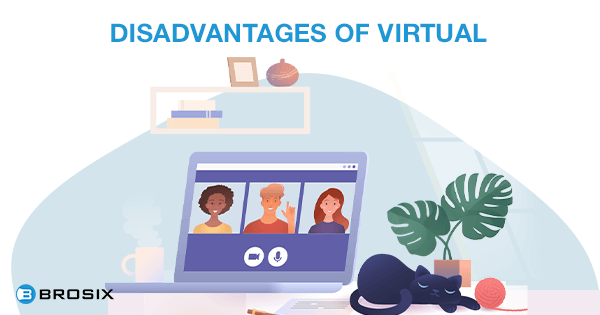
Among the cons of the virtual meeting are the following:
Lack of social interaction
Being at a distance, it’s often complex to establish interpersonal relationships beyond virtual meetings or video calls. This can sometimes affect the sense of belonging and commitment poorly.
Distractions
Employees are likely to be vulnerable to distractions that influence their concentration and work performance by not being within a workplace but at home or co-working spaces.
There’s also the matter of whether the person is in an inappropriate environment to fulfill their tasks in the first place.
Technological drawbacks
The Internet connection, the working condition of the PC or laptop and similar can affect the quality of the virtual meetings and the efficiency when working remotely. Not all team members may possess the necessary resources to tackle their tasks or conduct video conferences in the best way.
Lack of training
Although many tools are easy to use today, not all employees have the knowledge and skills to use them.
This inconvenience can be dealt with through a training program, with specific evaluations tailored to the needs of each employee.
Virtual meeting software
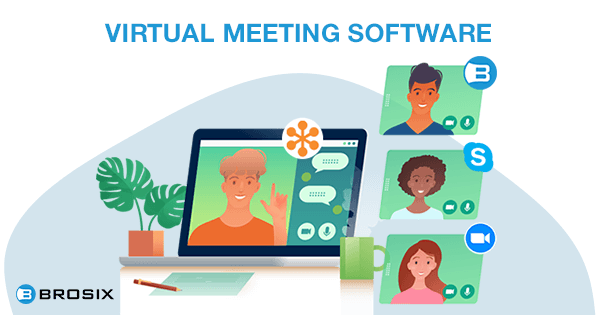
Some meeting platforms allow for effective virtual meetings thanks to their flexibility, functionality, and necessary features.
Brosix
Brosix is an instant messaging platform with extended privacy features. Along with the standard video calls, it has everything the business might need for effective team communication: administrative features, file and screen sharing, whiteboard, audio calls, and a lot more.
Skype
Skype is one of the go-to applications for organizing effective virtual meetings. It allows you to manage conversations and virtual meetings with several team members, send messages, share your screen, etc.
To use Skype, though, it’s necessary to have an Outlook account, which can be seen as a drawback; however, it’s also possible to register with your phone number.
Zoom
Zoom is one of the platforms that registered the most growth from the social isolation caused by the coronavirus. This platform also allows online meetings with several people, up to a thousand participants per video call in its paid service, with chat, screen sharing and sending files. It’s often used to teach classes and do video conferences at the business level.
GoToMeeting
This video conferencing platform stands out for its ease of use and, within its features, offers notifications before the virtual meeting begins. Up to 250 people can be connected for a call. It’s suitable for both mobile phones and computers.
[highlight_block title=”Check out some tools that can help you streamline communication:” link1=”https://www.brosix.com/blog/collaboration-apps/” link2=”” link3=”” ]
How to run video meetings in a more productive way
Make sure that tech’s on point
Starting video meetings is often followed by a set of questions such as Can you hear me, I can’t see you, You’re breaking up, etc.
To avoid all these inconveniences that can delay the agenda, give an image of unprofessionalism and prevent you from hosting a successful virtual meeting. Ensure to provide all users with the necessary technical requirements in advance and a small guide or instruction manual.
Obviously, if you meet with your colleagues, these instructions will be less detailed than if you have to schedule a video conference with clients or other companies. And it won’t be necessary for these guides to be so exhaustive if the people you’re meeting already use these types of tools regularly.
In any case, a host should make sure that all participants have the technical requirements to access the meeting, such as:
- A webcam
- Microphone and headphones to avoid sound issues
- Good Internet connection to avoid lag when sharing video or desktop
- Plugins or additional software if something needs to be installed for the session
- User accounts for specific applications
- Necessary links or other forms of access to the meeting
If it’s needed, participants can be asked to connect a day or a few hours before for a test session or to carry out tests internally to anticipate possible problems that may arise.
It’s also convenient, for example, to foresee potential issues and make sure that the virtual meeting can be extended by 5-10 minutes for technical reasons and invite attendees to access a few minutes before the scheduled start time to be able to proceed on the agenda with no delays.
Choose your platform and make the most out of it
There are many virtual meeting software options on the market. Some allow sharing files and screen sharing; others have integrated whiteboard systems, group chats, the possibility of putting participants on mute, creating parallel meeting rooms for small groups, etc. Some can be accessed via websites; others require installation. Some require registration; others are freely accessible, etc.
Choose the platform that best suits your circumstances, requirements and skills of the participants (simply following a link or answering a call is not the same as having to download a program on the computer and create an account to access the meeting).
And once the appropriate platform is chosen, explore it thoroughly to exploit all its options. Use the different tools that the virtual meeting room offers so that the participants’ experience is as pleasant and efficient as possible.
Plan in advance
Attendees must know in advance the reason for the meeting, the issues to be addressed, and the objectives. Also, notify them if they have to prepare any material to present during the meeting. If there’s time, it would be convenient that the same users can add and modify the order of the day.
On the other hand, you should be very careful when choosing who should and shouldn’t be in the meeting. There’s nothing more frustrating than being in a virtual meeting where you don’t know why you’re a part of it and there’s no need for your opinion or participation. This situation also occurs in face-to-face meetings and is equally annoying, but the feeling of “being invisible” increases in the online environment.
Everyone must get involved. To do this, plan the virtual meeting to include specific time frames for each participant and their turn to speak. Participation is crucial for maximum productivity and a successful virtual meeting, as is time for discussion and brainstorming.
Coordinate a work schedule with an agenda
Make sure to create an agenda for the virtual meeting and then send it to all participants beforehand. When you send this doc, also include the estimated time for the meeting.
This will facilitate productivity and team collaboration. It will also ensure that each participant knows their functions and how to act correctly in virtual meetings. What’s more, it’s convenient to rely on an organizational chart that specifies the topics and responsibilities.
Pay attention to the environment
The environment greatly influences the effectiveness and productivity of virtual meetings. That said, take care of the background, the lighting, the potential clutter on your desk, your clothes and appearance, as well as other potential factors of distraction, such as sounds or background noise.
Be a responsible moderator
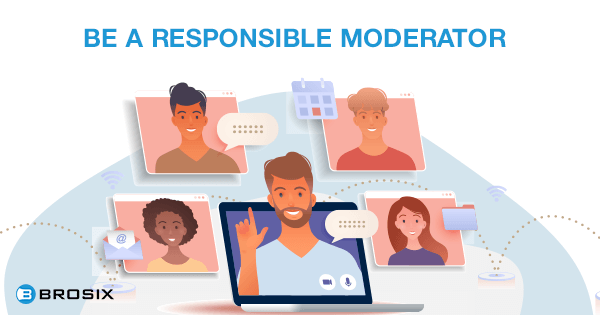
The host must moderate the virtual meeting to ensure that the conversations don’t overlap and even turn off the microphones of the participants who are not speaking at the time (if the selected virtual meeting software allows it) to avoid possible external noises.
Generally, when people are not too used to video conferencing, they remain silent if they are not expressly given the green light to speak. In face-to-face interactions, the opposite happens: we tend to interrupt each other constantly.
That is why the role of the moderator is especially relevant to grant speaking turns, end topics and open new ones following the planned agenda.
Create a sense of belonging
If professional video conferencing meetings are not planned and moderated correctly, the atmosphere can’t be comparable to face-to-face meetings. The jokes or casual talk that is common in personal gatherings will rarely appear. But how do we make it easier to connect the different participants in a meeting? How to bring out the feeling of group or belonging?
Again, planning is the answer. For example, we can create personalized backgrounds for each participant, including their name, position, the company logo, a representative image of the meeting theme, a funny background if the situation allows it, etc.
It’s worth taking some time at the beginning or at the end of the virtual meeting to get to know each other and talk about more personal issues. If they didn’t know each other previously, it would be only natural to give them a chance to introduce themselves. A great trick is to come up with a couple of questions yourself that participants then have to answer since not everyone is ready to speak about themselves on command.
It’s also vital that all participants have and use their cameras. Only if this affects the quality of the connection very negatively (due to poor quality Internet access) should they stop using it. Seeing people’s faces, reactions and moods are essential for a more personal and productive experience of virtual meetings.
Keep the length of the virtual meeting appropriate
Never prolong virtual meetings beyond what’s necessary to meet the agenda. Maintaining the interest and involvement of all attendees will be more difficult the longer the meeting. For this reason, it’s crucial to separate more minor issues that need to be discussed with only a handful of employees for other meetings and not mush it all in one.
Leave a record of what happened
It’s widespread for documents and information to be shared during virtual meetings. It’s not best to rely on these files and info even after the meeting is over.
Make sure to also send the critical files after the virtual meeting, including a detailed record of what was agreed and pending tasks. This will help to avoid any loose ends. In addition to this, participants should be encouraged to take notes.
[highlight_block title=”You might be interested in:” link1=”https://www.brosix.com/blog/team-culture/” link2=”https://www.brosix.com/blog/team-communication-tools/” link3=”https://www.brosix.com/blog/better-communication-co-workers/” ]
10 rules of etiquette for virtual meetings
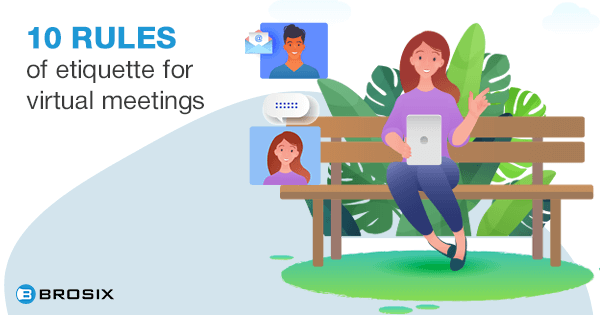
To create a comfortable and healthy work environment and avoid inconveniences, keep in mind the following virtual meeting etiquette rules for remote work:
- Dress appropriately. Casual but appropriate attire is a good match. The ideal is to adapt your appearance to the slightly more casual version of your typical office attire.
- Test camera and microphone in advance. It may seem obvious, but generally, we do not know the audio and video functionality until it’s time to connect.
- Take care of the framing. Avoid filling the screen with your face and opt for frames that go from the middle of your chest up.
- Mute the microphone when not speaking. During group video calls, it can be challenging to understand each other between the ambient noise, other people talking and the poor Internet connection. Therefore, if you know that you are not going to speak or ask anything in a period of time, it’s best to turn off the microphone.
- Approve the use of the camera. If everyone in the online meeting is keeping their camera on, so should you. Similarly, if the camera is turned off for everyone, feel free to keep your camera turned off as well. In general, make sure to follow the example.
- Do not all speak at the same time with others. Waiting for the other participant to finish talking to take your turn is crucial since every online call is delayed.
- Take care of the background. We must look for a background that’s as neutral and simple as possible since many objects or clutter can be a distraction for others. Avoid using the preset backgrounds unless it’s a personalized one with your company image.
- Focus on the online meeting. Don’t do other things while on camera to show respect. As a moderator, you can come off as really rude and unprofessional.
- Create an order. When you host a video call with several people simultaneously, you must lead the meeting properly and keep the order of the topics.
- Greet with joy. Everyone is tired, but that doesn’t mean that you as a host should be the first one to show just how grumpy and bored you are. Put some effort and greet everyone joyfully once you start the virtual meeting.
Safety guidelines for effective virtual meetings
Be mindful of a series of guidelines on safely hosting a successful virtual meeting without putting users and organizations at risk. They are as follows:
- Download the meeting platforms from official online markets or the provider’s website.
- Update the software regularly.
- As much as possible, avoid following links that are shared in the session chat, especially if you don’t know the person well.
- All users who access the meeting must do so with a password. In public applications, you must register with passwords not used in other services and not publicly share the meeting ID.
- The moderator of the video call decides if the call will be recorded. If this happens, audio and video indicators should be shown to all users.
- Do not accept calls/chats from unknown users. Everyone must enter with a name/nickname that’s recognizable to the administrator/moderator of the call.
- Configure the session so that audio and video indicators warn of the entry or exit of users and deactivate the automatic response to incoming calls. Exit the session if you know that no one is going to call.
- Consider video calls as an insecure communication channel and do not provide sensitive data such as passwords.
- The moderator must manage the participants’ connection, turn off microphones, disable content or the video signal.
Conclusion
Following these basic and essential premises, together with the general guidelines for organizing virtual meetings, we will achieve excellent communications and turn video conferencing into a perfect tool for professional activity.
It’s crucial to be aware that virtual meetings will be increasingly common since they have many advantages. Virtual meetings can mean high cost and time savings for companies, apart from getting in touch with the remote team when other options aren’t possible. The employees of such companies can reconcile their personal and professional lives better, increase productivity, and facilitate external collaborations, resulting in a better work outcome.
[highlight_block title=”Check out how Brosix can help you achieve your communication goals!” link1=”https://www.brosix.com/request-demo/” link2=”” link3=”” ]
